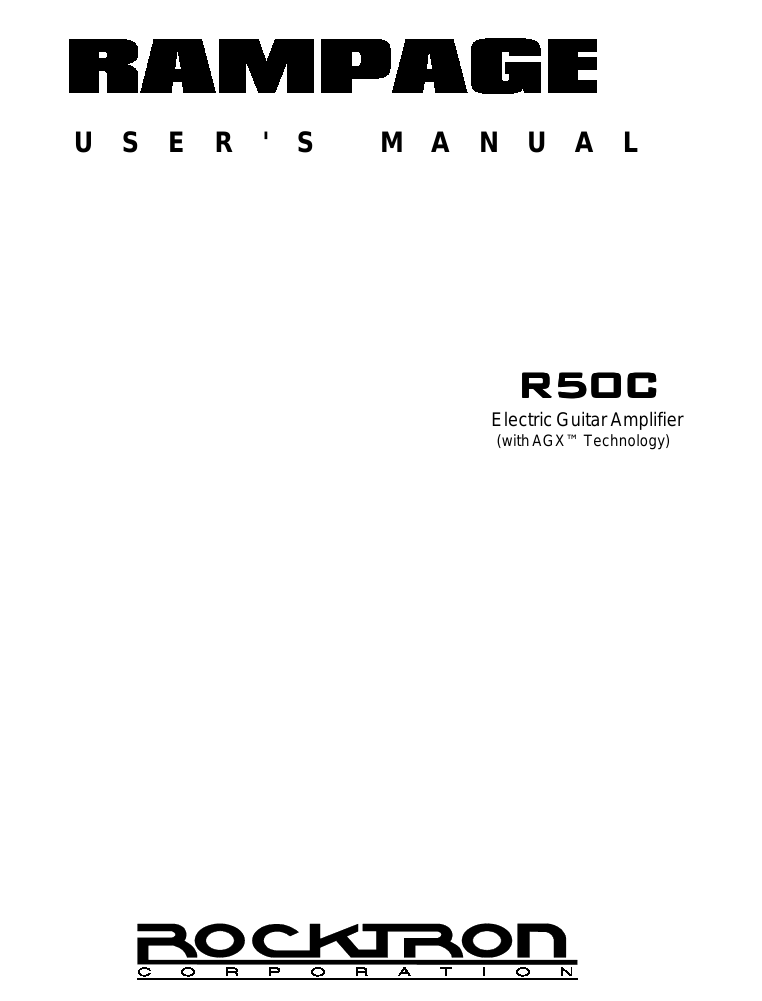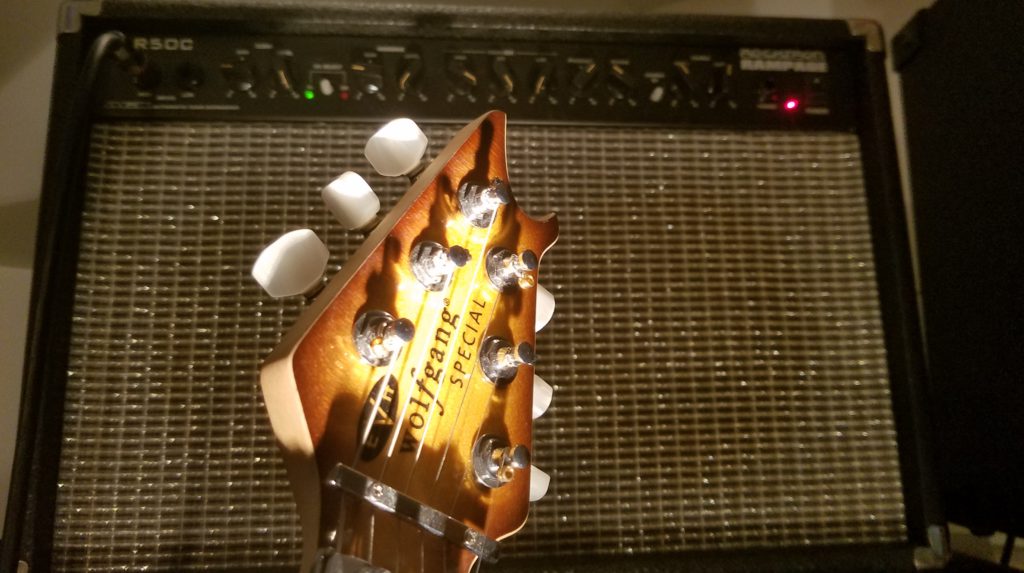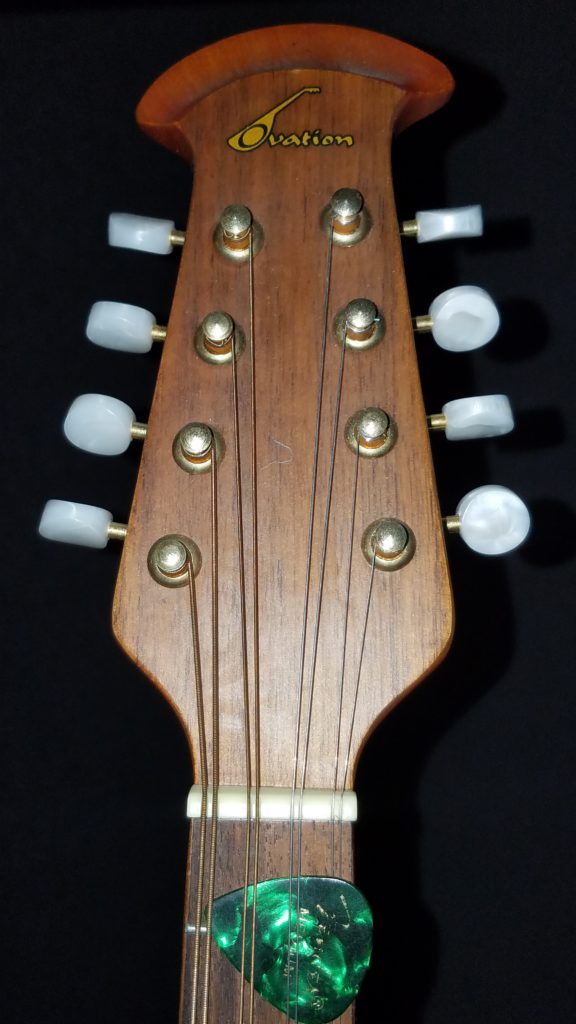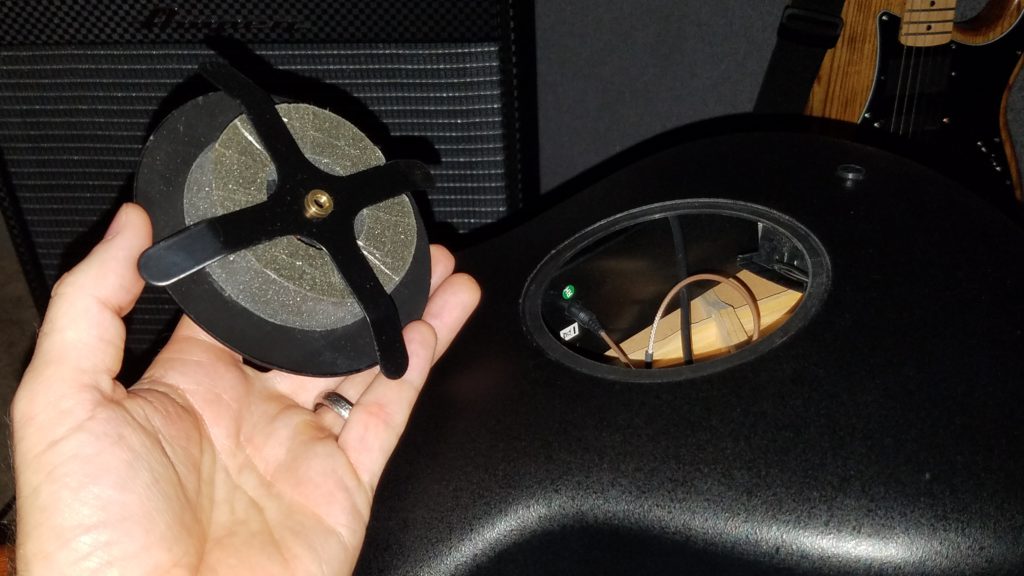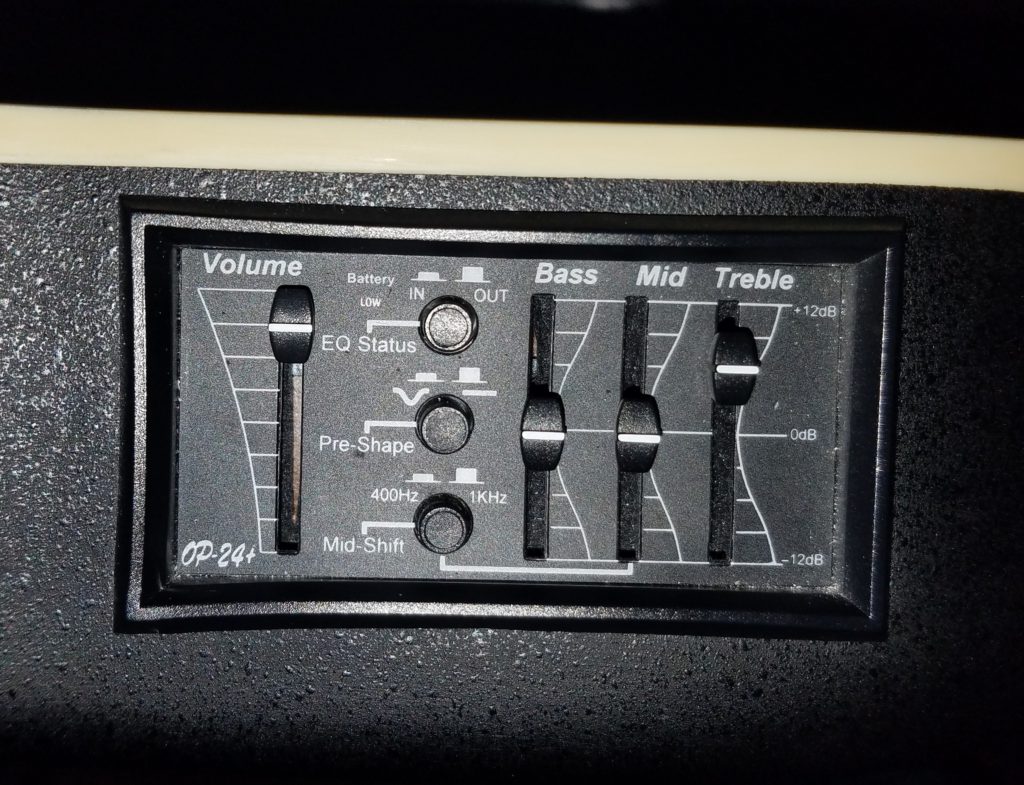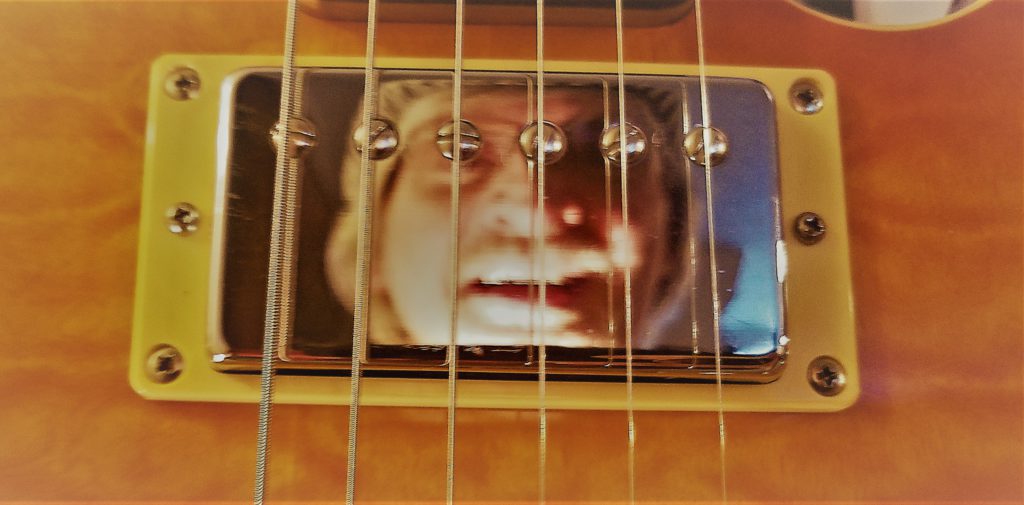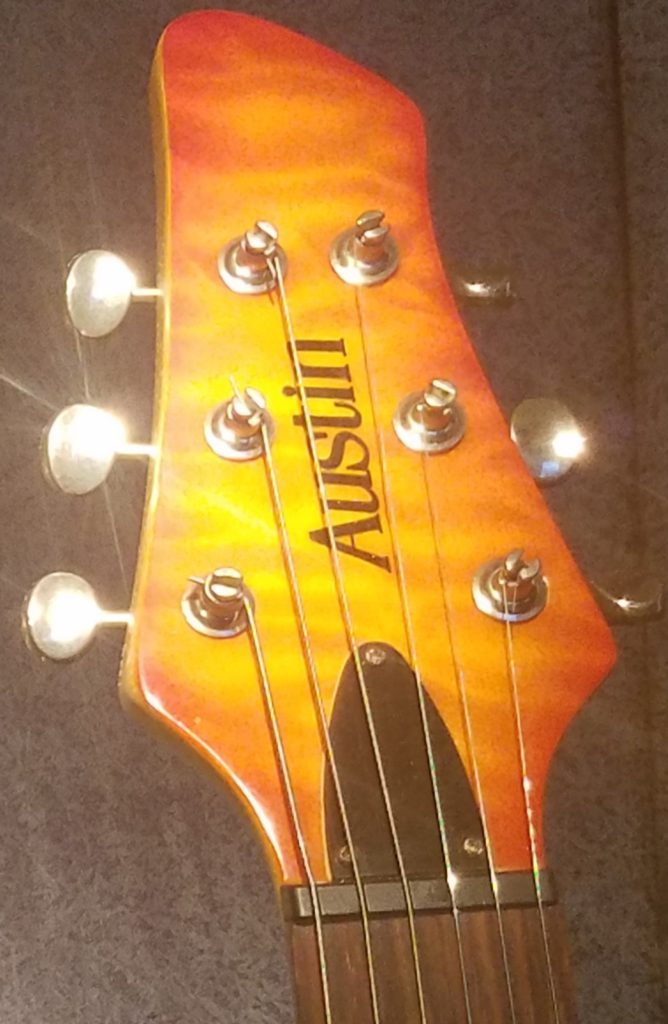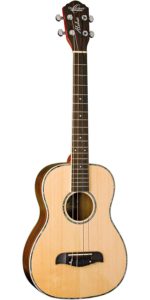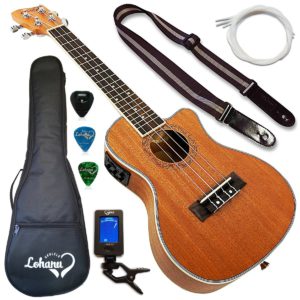When I was first learning guitar in my teenage years, I had two heroes:
- Paul Simon

- Eddie Van Halen

Both of these men have created seemingly unending genius work, captured as recordings for us to listen to, enjoy, and, often, be in awe of. And both of these men have taught me years & years of musical knowledge.
Through Paul Simon I learned finger-picking, lyric-writing, melody construction, harmony producing, story development, song forms, and…
… how to use a capo.
So it’s no surprise that today I’m filling you in on the Thalia capo, since decades later, here I am – still using all KINDS of capos with creativity and regularity.
The photo to the right shows you all the capos I’ve had for the past few decades, minus the ones I’ve given away to students (THAT happens a lot!). Quite a few, right?!

What the Heck IS it?
Okay, so… I know not everybody is familiar with capos, so lemme take just a few seconds to help those just now seeing the bandwagon, let alone jumping on it…
A capo is clamped onto any fret of any guitar that you like, enabling you to play the same fingerings in different keys. It’s often used to help a singer who can’t quite hit the high notes, or a singer who feels like a song is too low for them to sing. Clamp on the capo, and they’re singing higher or lower, depending on where you clamp it.
The capo is also awesome for songwriting. It provides ample opportunities to buck the trends of normalcy and really go into creative musical places that most other players never even consider. They change up your melodies, expand your song keys, enable you to sing in different (and often better-sounding!) registers, and even throw such a wrench into normal fingerings, if you use partial capos, that you’re bound to create something new and fresh when using them.
For all those reasons and more, I have used those capos often. At least half my songs on acoustic guitar use a capo. Sometimes even more than one capo.
Yes, I’m that nuts.
Anyway, for those who appreciate how a capo can unleash the creative dragons within, it’s always an excitement when a new capo rises to the top of the guitar necks. Recently, the Thalia capo indeed has, and it’s even improved my songwriting and live playing options…
And that’s why you’re here! So let’s clamp down and get pickin’ & grinnin’… !
The Unboxing!!
Here’s a quick vid’ of all that I got for GOING FOR IT with regards to the cool Thalia capo. It was even better than I expected….
And Therein Hangs A Tale – ia, ia, ia…
The Thalia capo! These capos are pretty new on the music scene. They first started appearing in the music market just a few years ago in 2014.
Did you know that without Taylor Swift, there would be no Thalia capos??!

True story: Thalia Bradley was just 8 years old when she was staring at her wall poster of Taylor with a beautiful guitar and she decided that Taylor needed a prettier capo to go along with her guitar, instead of the plain, plastic one shown in the poster which she thought “…wasn’t really cool.” Her words, not mine!

She told her dad Chris, an inventor and guitar player, about her idea, and they both set out to provide a solution to her dream.

Fast forward four years later: the dream became a reality when, after about 70 prototypes and a very successful Kickstarter campaign, they launched the Thalia Capo company and line of products. If you’d like to see a video by the company about their history and more details of their story, WATCH IT HERE.
One thing is for sure – their capos took the acoustic guitar world by storm! People loved ’em. Including me! The reasons why are numerous, but today we’ll look at the biggest reasons why Thalia is now THE go-to choice for those serious about using a capo!
Gotta Love Those Little Extras…
When you order a Thalia capo, you don’t just get a capo. There’s lots more in store, and a lot more options should you in the future like the product. Here’s what comes in each capo order:
- A Thalia Capo of your choosing
- A microfiber cleaning/gig pouch
- The Thalia “Standard Tension” & “High Tension” Rubber Fretpad Tuning kits
- A Capo jewel case
- A quick-start guide
- A Santos rosewood pick
- A Thalia sticker
The gig bag is great for keeping the capo in, since you never want it rubbing against anything. When something looks this amazing, you really don’t want to mar it in any way, so, yea… the gig bag is a definite “Yea, baby!”
I keep the rosewood pick for special occasions, when I need a really different transient sound for my playing. Any wooden pick is gonna get really beat up with chinks and dents the way I play, so I only pull it out if I want something different.
Or if we’re shooting another video to look cool. lol
Clench, Clench, Like Judi Dench!!
I just saw yesterday that Judi Dench is making a full documentary on how she’s a tree-hugger; all her life she’s absolutely loved trees.

Well, Thalia capos hug trees too! Or… at least parts of them – the parts that have been shaped into a guitar neck!!
But what sets Thalia apart from other tree-huggers is the WAY they clench the neck. It sounds counter-intuitive, but to put on a Thalia capo, or to take it off, you actually squeeze in from the top and bottom, like you’re doing a barre chord. When you clench, the internal mechanics release pressure on the neck and allow you to slide it on or off.
The opposite is true when you want it to grab on – you release tension on the outside, and its inside grabs tight.
Weird, right? But it works!
Now I know why he had to go through 70 prototypes to get one that works great… lol
The Thalia Tune-up!

As someone who has used the capo literally thousands of times for recording sessions, writing sessions and live concert performances, I can tell you, with no small amount of chagrin, that most capos put your strings out of tune when you put them on.
This is why, when using a capo in concert, I would always put on the capo, THEN tune my guitar. If I tuned the open strings on my guitar correctly, THEN put on the capo… my audience and I would always hear what I can only call “grimace tones” and I’d have to tune on the fly, which always sucks. Being “capo sharp” was just something you had to live with.
Until now! Thalia set out to solve this problem. They had to first, of coure, figure out what the real problem WAS. Chris researched and experimented with capo types until he discovered that capos put us out of tune because most capos only have ONE ARCH shape that does not change. That one shape is then applied to many guitars which all have DIFFERENT arch shapes (called the neck “radius”) that don’t really fit the shape of the capo!
Today, Thalia capos amazingly dismiss this off-putting tuning issue by including, with every capo they make, an assortment of different “tuning pads”. You choose which tuning pad to place into your Thalia capo by consulting their included brand list. The list tells you which pad to put in based on what brand of guitar you have.

Each guitar is made with a specific fretboard “radius”, which is the amount of convex curve the fretboard has. Chris discovered that when you apply a capo with a radius that matches the guitar you’re putting it on, tuning issues never appear.
YESSSSSS!! Finally, someone has banished the dreaded dissonant beast from our midst. For the first time, no matter what fret I put this capo on, I’m still in tune.
That, my friends, has never happened ’til now. Thanks, Chris and Thalia!!
Don’t Fret – There’re Pads Galore!
So what about those “TUNING PADS”?? As mentioned above, every Thalia capo package comes with a slew of pad options, which allows those of us with multiple guitars to have the right radius represented and ready at the drop of a drum fill.

TWO packets of fretpads are sent with every Thalia capo: the “Standard Tension” packet, and the “High Tension” packet. EACH packet contains the following radii adapter fretpads:
- 0″ for Classical
- 7.25″
- 9.5″
- 10″
- 12″
- 15″
- 16″
That’s FOURTEEN different tuning pads in all! It’s pretty much given that this will cover you for most everything you’ll come across in acoustics. One purchase, done. I like that.
The “High Tension” fretpads are what you’ll use on 12-string guitars, Ukuleles, Banjos and certain guitars with low profile necks. These pads are 2mm taller than the “standard tension” fretpads.
The Quickstart Guide that comes with each capo directs you to exactly which one you should be using for whichever guitar you own.
If by chance you own a guitar that’s not on their list, if you simply know the radius of your guitar neck you can then just pick the appropriate fretpad.
If you don’t know the radius, and you can’t find the info from the manufacturer, there’s a simple way to measure the radius and find out. The instructions are on the Thalia website.
Oh, and I just have to mention this… I really like that these fretpads extend OVER the fretboard to the side as well. What that means is there’s no metal or other material that might slam into the beautiful neck of the instrument you spent hundreds, if not thousands, of dollars on. No neck scratches will ever occur because of your Thalia capo. Another great feature!
All the Right Moves!
The Thalia company also wanted to improve another common capo complaint: how difficult it is to re-position the capo on different frets.

In the past, when using capos made by other companies, I would often have to use both hands to take my capo on and off. There’s even one that rolls up and down the neck to change frets, but you’d usually have to use both hands to roll it since it was clamped so tight.
This got very old, so when some companies came out with the simple clamp capos that only needed one hand, I jumped on their boat right away.
But the same issue of bad intonation came up again and again. I’d just have to tune with the capo on, retune with it off, etc. It was the only way around it.
No there’s no need for any of that. With the Thalia, you compress it slightly and swiftly move it anywhere on the neck you want. When you get there, you simply let go and “Boom!”, you’re as free as bird now.
And this bird you cannot change.
Sorry – couldn’t resist! lol
She’s a Beauty… !
If you’re here because of a sudden interest in getting a Thalia capo, I BET you I know why.
Because they look freakin’ AMAZING!!

Chris told us in the video above that the artistic element was always at the top of his list of “must have’-s when developing these capos. That’s no surprise; just a cursory glance at the beautiful woods, shells, metals and crystals that are available to you for your capo is instantly mouth-watering. My G.A.S. attack started the first time I saw one, and though it took a few months before I pulled the trigger… its beauty… its beauty was so… sooo… intoxicating!
The way you can match or combine the tone woods with different impressive inlays allows you to really come up with a unique capo that’s all your own. And when you play with one, as I do, every time you go to move it to a different fret, you just KNOW that the people seeing it are thinking YOU are something special, because your guitar (hopefully) and your capo obviously are.
Your capo as a work of art? Whodduh thunk?? But using sustainably harvested woods and shell inlays, laser cutting the inlays and applying them by hand to each capo, the Thalia company gives you just that. Artistry, beauty, and cutting-edge functionality. Now that’s a killer combination.
Really, buying a Thalia capo is way beyond a utilitarian business purchase. It’s creating a showpiece that will coincide with your brand – showing how discerning and exclusive your gear is, and thus accentuating how special your music is.
And that, we all know, is what it’s really all about.
Thalia & Teaj
The Thalia capo has made a big difference in how I approach using the capo, both in performance and, especially, during songwriting. Its quality is second to none, its options seem limitless, and its versatility is a rare treat indeed.
The biggest change it’s brought about in my playing is that now I put the capo on from the FRONT, from the high “E” side of the neck. I never did that before; I always approached the neck with a capo from the LOW “E” side.

Because this capo is designed to be slid up and down the neck quickly and easily with your LEFT hand (if you’re a right-hand player), I took the risk and started using it as they suggest. Outcome? I love it. It indeed is easier that way, but only because of how it’s designed.
I do have to angle the capo somewhat to allow room for my fingers on some chords, like standard “A”, but other than that using it is no worse than any other capo I’ve slipped on through the years, and in many ways better!
I also took the road less traveled and bought the “Partial” tuning kit to go along with my normal tuning pads. These cover only Some strings and leave others open at the nut, so I can write songs in bizarre, undecipherable tunings.
I even use the partial capos with my guitar in alternate tunings! Talk about whacked!!! lol
Lastly, this capo has started me keeping the capo on the guitar nut when not in use. Before, I would either keep the capo on the top of the headstock (if it clamped), or have it lying on some of my equipment, or in my pocket for a gig. This is a much more elegant and impressive method, and serves to show off even more the beautiful capo wood and how it complements the wood on my guitar.
It’s not often that a piece of music gear changes HOW you play by such a large degree. For something so small too, to have such an effect… pretty unbelievable.
But wicked cool!!
Strumming Up Support
In the retail product world, it’s either put up, or shut up. And there’s one sure way to put up that every customer will recognize as the real deal:

The LIFETIME WARRANTY!
Thalia puts it on all their capos. They understand you’re paying more to get a lot more, so they pony up and have got yer back. In short, I get the feeling that the Thalia company is a very grateful and helpful group of people.
If you ever run into any issues that aren’t already addressed on their very comprehensive and insightful Troubleshooting Page, a simple call to them will get things cleared up. Just keep in mind, though, that they open at 10 a.m. PACIFIC time, so call accordingly.
Since I’m in Michigan I can’t reach ’em ’til after 1 my time, but they’ve always been very accommodating and so very nice.
In the final fret, the warranty says it all. These people are serious about making, for you and me, the very best capo on the planet!
Strike the Pose!

I think Chris, the owner of the company, really said it best when describing what his goal was in creating the Thalia capo:
“Design, when you have this gorgeous form that meets just an amazing function… that marriage is what really, to me, makes a product exceptional.”
That combination is exactly why I ordered my own Thalia capo and continue to use it to this day. I have the Indian Rosewood capo with the Brushed Black finish. It matches well with the fretboards on most of my acoustics.
One day I’m sure I’ll even spring for the inlaid name and other fancy-schmancy accessories, but for right now I have what matters most…
… the capo that works better than all my other ones combined. The Thalia. 🙂
If you use the links near the top of this post and get your own, please share with us your own testimonial. Is it your best capo too? Has it revolutionized your playing options? And most important to your family… does it make you LOOK COOL??! LOL
Let us know by leaving a comment. We here at Seriousgas always appreciate a good gear lust story.
Now, move up a couple frets and go… make… sounds!!
Teaj










